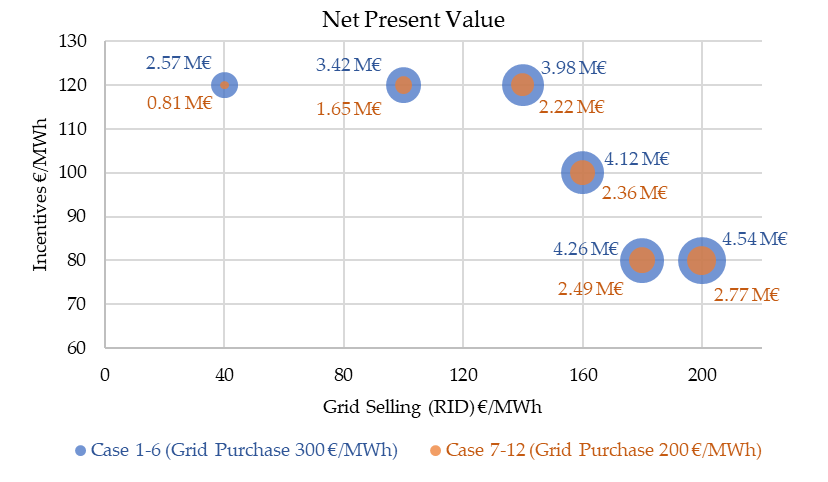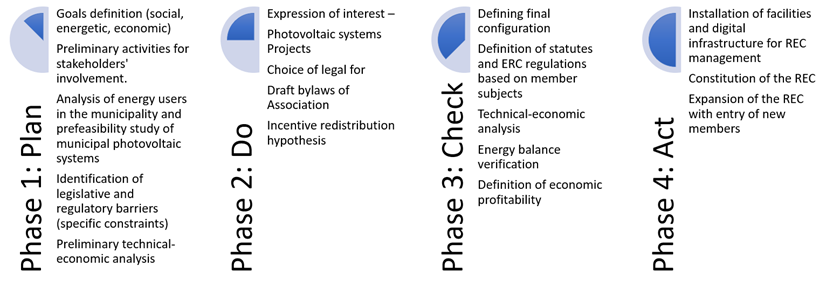
| Version | Summary | Created by | Modification | Content Size | Created at | Operation |
|---|---|---|---|---|---|---|
| 1 | Elisa Moretti | -- | 1453 | 2023-08-29 17:09:41 | | | |
| 2 | Dean Liu | Meta information modification | 1453 | 2023-08-30 02:43:53 | | |
Video Upload Options
The pressing necessity to address climate change calls for reducing carbon emissions in the energy sector. Renewable energy communities (RECs) provide environmental, financial, and societal advantages that facilitate the shift towards sustainable energy sources.The growth of renewable energy communities (RECs) in Italy is the result of collaborative efforts from both public and private sectors, and the crucial involvement of public administrations (PAs) in promoting and expanding RECs is undeniable. A renewable energy community, especially when facilitated and supported by public administration, can be an effective solution to overcome the limitations and difficulties in implementing renewable energy sources, especially in historic and small towns.The development of RECs in Italy and the pivotal role played by public administrations as catalysts in the formation of RECs is investigated through a case study in the Municipality of Assisi.
1. Introduction
The urgent need to reduce climate-altering emissions and mitigate global warming's impacts is complicated by technological, economic, and social challenges, worsened by post-COVID-19 recovery [1][2]. The Russian-Ukraine conflict caused an energy market crisis, emphasizing the significance of the ongoing energy transition [3]. Renewable energy is pivotal in achieving a sustainable, low-carbon future. International and national strategies like the 2030 Agenda for Sustainable Development and EU policies are vital, but local sustainable approaches are essential too [4][5]. Renewable energy communities (RECs) offer a promising solution. They unite local stakeholders to develop, own, and manage renewable energy projects, fostering collaboration and reshaping the energy landscape.
Renewable energy communities are legal entities and consist of two main types of users/members: prosumers and consumers. Prosumers actively participate in the energy production process and play an active role within the community, while consumers are passive users who solely consume the energy generated. Prosumers typically own one or more renewable energy systems, and there can be multiple prosumers within an energy community. The nature of this new energy management system is based on voluntary and open participation, which means that the type (citizens, small and medium-sized enterprises (SMEs), local authorities, etc.) and number of members in the REC can vary. Benefits include decentralized energy production, economic growth, social cohesion, democratization of energy, and reduced external energy dependence. The European Commission recognizes energy communities as pivotal, enacting directives to promote renewable energy usage and sharing. Italy, before EU regulations, introduced RECs, and subsequent legislation eased constraints, expanding REC participation. Collaborative efforts between public and private sectors, especially public administrations, have propelled the growth of RECs in Italy, offering a solution for renewable energy implementation, even in historically significant and small towns.
2. Renewable Energy Installations: State of the Art and Development Trends
A literature review on renewable energy communities (RECs) in Italy and Europe is carried out. The focus is on organizational structures, technology choices, policy frameworks, and socio-economic impacts of RECs. An Italian report identified 67 operational RECs with a total capacity of 1.4 MW, mostly photovoltaic [6][7]. One case study is the "Comunità Energetica Via dei Partigiani" [8], an example of a bottom-up established community, whic use smart meters for energy optimization. A study by Cirone et al. [9] explores a planned REC in southern Italy, replacing heating systems with electric heat pumps and PV systems, finding that higher battery capacity significantly reduces grid energy consumption and CO2 emissions. Ceglia et al. [10] analyze an energy community in Italy using PV systems and air-to-air heat pumps, achieving significant energy savings and CO2 emission reductions. The passage also includes non-Italian examples. Schoonschip in Amsterdam [8] is a collaborative sustainable neighbourhood with smart grids, shared solar panels, and eco-friendly features. Efthymiou et al. [11] present a methodology for REC development in Greece, assessing technical and economic aspects for optimal photovoltaic installations.
3. The Case Study
The case study focuses on Assisi, a small Italian town with historical significance and a population of around 28,000. Assisi adopted a Sustainable Energy and Climate Action Plan (SECAP) [12] to reduce CO2 emissions by 40% by 2030 (Figure 1). The plan includes measures for energy efficiency, renewable energy, and climate adaptation. Assisi joined the European City Facility program to accelerate SECAP goals through building renovations and increasing renewable energy production, including forming a renewable energy community (REC). The town has a growing number of photovoltaic installations, with smaller systems dominating. The installed capacity has risen steadily over the years, aligned with national trends, but Assisi needs to increase its capacity significantly to meet national targets [13][14].
4. Methodology
The methodology focuses on establishing a successful Renewable Energy Community (REC) in Assisi. A top-down/PA-driven model is chosen due to the site-specificity and political willingness [15]. The REC involves public and private members and aims to offset emissions in the historic centre with renewable energy from industrial areas. A SWOT analysis evaluates the model's potential and challenges (Figure 2). Constraints include architectural, spatial, and procedural issues. Landscape preservation limits renewable installations, while limited urban space hampers larger installations. Complex authorization procedures and community involvement are also challenges [16]. The REC aims to achieve 2 MWp of photovoltaic power by 2030, benefiting both the sector and achieving SECAP objectives [17]. The REC enables renewable source integration, energy storage, home automation, sustainable mobility, and citizen participation. Distributed generation reduces energy losses from long-distance transport. Detailed analysis covers energy and economic aspects. Clusters are selected, and a distribution plan for photovoltaic installations is established, favouring non-residential users. Energy balance metrics are defined, including physical and virtual self-consumption indices. Economic analysis accounts for revenue streams, like selling to the grid and shared energy within the REC, alongside operational costs. The study contributes to the feasibility of the REC model, considering energy production, consumption, and financial viability.

Figure 2- SWOT analysis of the proposed model of municipality-led REC
5. Results and Discussion
Results provide a detailed insight into energy and economic outcomes of the REC configuration (Table 1). Energy metrics include production, consumption, self-consumption, and sharing within the community. For instance, 67% of production meets consumption, with 51% self-consumed and 49% fed into the grid. Shared energy accounts for 55.5%. Environmental impact is also assessed, saving 447 tons of oil equivalent and avoiding 610 tons of CO2. Economic analysis reveals costs and revenues. CAPEX and OPEX are detailed, and revenues from energy sales, self-consumption, and shared energy are considered. A discount rate of 3.21% determines Net Present Value (NPV), Simple Payback Period (10 years), Discounted Payback Period (11 years), and Internal Rate of Return (IRR) at 13.94%. These findings enhance understanding of the REC's energy performance and financial viability, guiding decisions on future configurations.
Table 1. Energy and Economic Parameters

The impact of changes in incentives on shared energy and variations in energy prices on the economic analysis of Renewable Energy Communities (RECs) are analyzed(Figure 3). Different scenarios are simulated to understand how these factors influence Net Present Value (NPV) and Simple Payback Period. The formula for calculating incentives based on zonal hourly price of electricity (PZ) is provided. Various scenarios are tested with different incentive values and grid electricity purchase prices. Results show that grid purchase price significantly affects NPV. Additionally, the discussion delves into the influence of shared energy on economic indicators. Three scenarios (Base, Intermediate, Optimal) with different levels of self-consumption and shared energy are examined. Higher self-consumption leads to increased revenue and reduced payback periods. An optimal scenario with total sharing of energy fed into the grid shows the best profitability. The municipality's role in promoting RECs is highlighted.
Figure 3. Alternative configurations—Net Present Values

The municipality acts as an aggregator and promoter, conducting cost-benefit analysis, defining legal frameworks, and engaging community members. The municipality's efforts in promoting renewable energy through initiatives like citizen's energy desk, awareness conferences, and surveys are discussed, along with their role in formulating municipal regulations to support RECs. The PDCA (Plan, Do, Check, Act) approach is emphasized for effective REC implementation (Figure 4). Overall, the discussion provides insights into the economic dynamics of RECs, the impact of various factors on profitability, and the importance of active community involvement and municipal support in promoting sustainable energy practices.
Figure 4. PDCA approach for RECs.

6. Conclusion
The potential of renewable energy communities (RECs), particularly with strong public administration (PA) support, to overcome barriers in renewable energy implementation, is highlighted by the case study of Assisi, Italy. Active community engagement is a key aspect of the municipality's approach, fostering ownership and awareness. The participatory model mitigates resistance to renewable installations. The study emphasizes cost-benefit analysis for REC planning. The study's findings align with existing literature and underscore the importance of maximizing self-consumption for financial success. It proposes a replicable model for implementing medium-sized community energy projects with strong PA support, overcoming constraints in historic towns. Engaging the community, utilizing local resources, stimulating the economy, and reducing emissions are vital for a sustainable energy transition. Overall, the Assisi case study provides a blueprint for other municipalities aiming to establish resilient, eco-conscious communities through renewable energy initiatives.
References
- Matúš Mišík; Andrej Nosko; Post-pandemic lessons for EU energy and climate policy after the Russian invasion of Ukraine: Introduction to a special issue on EU green recovery in the post-Covid-19 period. Energy Policy 2023, 177, 113546.
- Gabriele Cassetti; Baptiste Boitier; Alessia Elia; Pierre Le Mouël; Maurizio Gargiulo; Paul Zagamé; Alexandros Nikas; Konstantinos Koasidis; Haris Doukas; Alessandro Chiodi; et al. The interplay among COVID-19 economic recovery, behavioural changes, and the European Green Deal: An energy-economic modelling perspective. Energy 2023, 263, 125798-125798.
- Fabrizio Ferriani; Andrea Gazzani; The impact of the war in Ukraine on energy prices: Consequences for firms’ financial performance. Int. Econ. 2023, 174, 221-230.
- UN General Assembly. Transforming Our World: The 2030 Agenda for Sustainable Development, 21 October 2015, A/RES/70/1, United Nations. Available online: https://sdgs.un.org/sites/default/files/publications/21252030%20Agenda%20for%20Sustainable%20Development%20web.pdf
- European Commission. Fit for 55: Delivering the EU’s 2030 Climate Target on the Way to Climate Neutrality. 2021. Available online: https://eur-lex.europa.eu/legal-content/EN/TXT/HTML/?uri=CELEX:52021DC0550&from=EN
- L egambiente Rapporto Comunità Rinnovabili 2022; Legambiente: Rome, Italy, 2022.
- GSE. Energia e clima in Italia—Rapporto trimestrale Q4/2022–2023. Available online: https://www.gse.it/dati-e-scenari/rapporti
- Elena Tarpani; Cristina Piselli; Claudia Fabiani; Ilaria Pigliautile; Eelke J. Kingma; Benedetta Pioppi; Anna Laura Pisello; Energy Communities Implementation in the European Union: Case Studies from Pioneer and Laggard Countries. Sustain. 2022, 14, 12528.
- Daniela Cirone; Roberto Bruno; Piero Bevilacqua; Stefania Perrella; Natale Arcuri; Techno-Economic Analysis of an Energy Community Based on PV and Electric Storage Systems in a Small Mountain Locality of South Italy: A Case Study. Sustain. 2022, 14, 13877.
- F. Ceglia; P. Esposito; A. Faraudello; E. Marrasso; P. Rossi; M. Sasso; An energy, environmental, management and economic analysis of energy efficient system towards renewable energy community: The case study of multi-purpose energy community. J. Clean. Prod. 2022, 369, 369.
- Emmanuel N. Efthymiou; Sofia Yfanti; George Kyriakarakos; Panagiotis L. Zervas; Panagiotis Langouranis; Konstantinos Terzis; George M. Stavrakakis; A Practical Methodology for Building a Municipality-Led Renewable Energy Community: A Photovoltaics-Based Case Study for the Municipality of Hersonissos in Crete, Greece. Sustain. 2022, 14, 12935.
- SECAP (Piano d’Azione per l’Energia Sostenibile e il Clima) Città di Assisi, October 2020. Available online: https://www.comune.assisi.pg.it/wp-content/uploads/2022/08/31_8_2022_SECAP.pdf
- GSE. Atlaimpianti. Available online: https://atla.gse.it/atlaimpianti/project/Atlaimpianti_Internet.html
- Stamponi, E.; Cardinali, M.; Fondacci, L.; Moretti, E.; Cotana, F.; Proietti, S.; Broccolo, B.M.; Fortini, P. The role of the citizen insustainability: The Sustainable Energy and Climate Action Plan for the Municipality of Assisi. In Atti del XXI Congresso NazionaleCIRIAF 2021; Morlacchi Editore University Press: Perugia, Italy, 2021; pp. 266–277.
- Anita Tatti; Sibilla Ferroni; Martina Ferrando; Mario Motta; Francesco Causone; The Emerging Trends of Renewable Energy Communities’ Development in Italy. Sustain. 2023, 15, 6792.
- Federico De Santi; Matteo Moncecchi; Giuseppe Prettico; Gianluca Fulli; Sergio Olivero; Marco Merlo; To Join or Not to Join? The Energy Community Dilemma: An Italian Case Study. Energies 2022, 15, 7072.
- Moretti, E.; Stamponi, E.; Stoklin, S.; Eugeni, M.; Cavazzoni, C.; Marchetti, M.L.; Fortini, P.; Proietti, S. La prima ComunitàEnergetica rinnovabile di Assisi: Analisi tecnico-economica e legale. In Proceedings of the XXIII Congresso Nazionale CIRIAF“Sviluppo Sostenibile, Tutela dell’Ambiente e della Salute Umana”, Perugia, Italy, 13–14 April 2023; Morlacchi Editore UniversityPress: Perugia, Italy, 2023; pp. 349–368, ISBN 978-88-9392-442-9.




